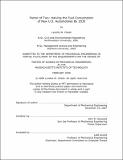| dc.contributor.advisor | John B. Heywood. | en_US |
| dc.contributor.author | Cheah, Lynette W | en_US |
| dc.contributor.other | Massachusetts Institute of Technology. Dept. of Mechanical Engineering. | en_US |
| dc.date.accessioned | 2008-11-07T14:10:16Z | |
| dc.date.available | 2008-11-07T14:10:16Z | |
| dc.date.copyright | 2008 | en_US |
| dc.date.issued | 2008 | en_US |
| dc.identifier.uri | http://hdl.handle.net/1721.1/42918 | |
| dc.description | Thesis (S.M.)--Massachusetts Institute of Technology, Dept. of Mechanical Engineering, 2008. | en_US |
| dc.description | This electronic version was submitted by the student author. The certified thesis is available in the Institute Archives and Special Collections. | en_US |
| dc.description | Includes bibliographical references (p. 63-64). | en_US |
| dc.description.abstract | This thesis examines the vehicle design and sales mix changes necessary to double the average fuel economy of new U.S. cars and light-trucks by model year 2035. To achieve this factor of two target, three technology options that are available and can be implemented on a large scale are evaluated: (1) channeling future vehicle technical efficiency improvements to reducing fuel consumption rather than improving vehicle performance, (2) increasing the market share of diesel, turbocharged gasoline and hybrid electric gasoline propulsion systems,and (3) reducing vehicle weight and size.The illustrative scenarios demonstrate the challenges of this factor-of-two improvement -- major changes in all these three options would need to be implemented before the target is met. Over the next three decades, consumers will have to accept little further improvements in acceleration performance, a large fraction of new light-duty vehicles sold must be propelled by alternative powertrains trains, and vehicle weight must be reduced by 20-35% from today. Theadditional cost of achieving this factor-of-two target would be about 20% more than a baseline scenario where fuel consumption does not change from today's values, although these additional costs would be recouped within 4 to 5 years from the resulting fuel savings.Thus, while it is technically feasible to halve the fuel consumption of new vehicles in 2035, aggressive changes are needed and additional costs will be incurred.Results from this study imply that continuing the current trend of ever increasing performance and size will have to be reversed if significantly lower vehicle fuel consumption is to be achieved. | en_US |
| dc.description.statementofresponsibility | by Lynette W. Cheah. | en_US |
| dc.format.extent | 64 p. | en_US |
| dc.language.iso | eng | en_US |
| dc.publisher | Massachusetts Institute of Technology | en_US |
| dc.rights | M.I.T. theses are protected by
copyright. They may be viewed from this source for any purpose, but
reproduction or distribution in any format is prohibited without written
permission. See provided URL for inquiries about permission. | en_US |
| dc.rights.uri | http://dspace.mit.edu/handle/1721.1/7582 | en_US |
| dc.subject | Mechanical Engineering. | en_US |
| dc.title | Factor of two : halving the fuel consumption of new U.S. Automobiles by 2035 | en_US |
| dc.title.alternative | Factor of 2 : halving the fuel consumption of new United States Automobiles by 2035 | en_US |
| dc.type | Thesis | en_US |
| dc.description.degree | S.M. | en_US |
| dc.contributor.department | Massachusetts Institute of Technology. Department of Mechanical Engineering | |
| dc.identifier.oclc | 246723370 | en_US |
